In The Greenhouse (09/06)
Welcome to orchid season. All of the precious sleeping beauties that have lain dormant all those winter months are finally awake and putting on a splendid display. With this, my largest orchid post ever, I would like to show you the symptoms of my spring fever. A word of warning, though: it is highly contagious... Dendrobium nobile 'Joyful Heart'. I purchased this Himalayan plant for R50,00 from MC Orchids several years ago. Then, it was a cute little ikebana of a plant, with a couple of spindly canes with velvety pink flowers on them. Since then, it has grown into a splendid specimen plant, a monster that entirely covers the large coconut-fibre basket it grows in. I completely stop watering it by the end of May, when its resting period commences. All the leaves from the previous season's growth drop off, leaving the canes completely bare. By the end of July, tiny buds start to form at the nodes of the bare canes. These develop into gorgeous trusses of flowers like the one you see here. My favourite is the inviting, dark velvety centre and the dangerously spicy scent. Furry.
Dendrobium nobile 'Joyful Heart'. I purchased this Himalayan plant for R50,00 from MC Orchids several years ago. Then, it was a cute little ikebana of a plant, with a couple of spindly canes with velvety pink flowers on them. Since then, it has grown into a splendid specimen plant, a monster that entirely covers the large coconut-fibre basket it grows in. I completely stop watering it by the end of May, when its resting period commences. All the leaves from the previous season's growth drop off, leaving the canes completely bare. By the end of July, tiny buds start to form at the nodes of the bare canes. These develop into gorgeous trusses of flowers like the one you see here. My favourite is the inviting, dark velvety centre and the dangerously spicy scent. Furry.
 Laeliocattleya Trick or Treat. How delicious is this? Bright vermillion, starry flowers are completely irresistable and there are many similar Laeliocattleyas to choose from. Lc. Trick or Treat is one of the best and most famous of these miniature jewels and was hybridised in the 1970's by the experts at Stewart Orchids. Zesty.
Laeliocattleya Trick or Treat. How delicious is this? Bright vermillion, starry flowers are completely irresistable and there are many similar Laeliocattleyas to choose from. Lc. Trick or Treat is one of the best and most famous of these miniature jewels and was hybridised in the 1970's by the experts at Stewart Orchids. Zesty.
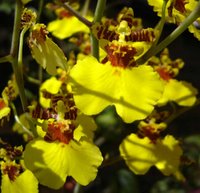 Oncidium hybrid. Karen Little gave this plant to me for my birthday about two years ago. The tag listed it as Oncidium flexuosum, which it definitely is not. The size and shape of the pseudobulbs is completely different, not to mention the patterning on the flowers. It's very possible that Onc. flexuosum features somewhere in this plant's parentage, but without a proper tag, it is impossible to be certain. Whatever the exact genetic make up, this is a superior plant with a large (almost 1m tall!) and branching inflorescence carrying hundreds of perfectly formed yellow flowers with red and brown markings. It grows outside in bright but filtered sunlight, receiving lots of water and fresh air. I love it. Bright.
Oncidium hybrid. Karen Little gave this plant to me for my birthday about two years ago. The tag listed it as Oncidium flexuosum, which it definitely is not. The size and shape of the pseudobulbs is completely different, not to mention the patterning on the flowers. It's very possible that Onc. flexuosum features somewhere in this plant's parentage, but without a proper tag, it is impossible to be certain. Whatever the exact genetic make up, this is a superior plant with a large (almost 1m tall!) and branching inflorescence carrying hundreds of perfectly formed yellow flowers with red and brown markings. It grows outside in bright but filtered sunlight, receiving lots of water and fresh air. I love it. Bright.
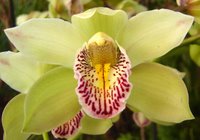 Cymbidium hybrid. This is an orphan I inherited from my aunt when she moved to George. It had a name tag nestled in the potting mix, but it was too eroded to be read. I repotted the plant immediately, dividing it and placing my divisions in terracotta pots filled with large chunks of composted pine bark. This year, the divisions each made two spikes of graceful jade blooms with intricately patterned lips. Graceful.
Cymbidium hybrid. This is an orphan I inherited from my aunt when she moved to George. It had a name tag nestled in the potting mix, but it was too eroded to be read. I repotted the plant immediately, dividing it and placing my divisions in terracotta pots filled with large chunks of composted pine bark. This year, the divisions each made two spikes of graceful jade blooms with intricately patterned lips. Graceful.
 Masdevallia Copper Angel 'Highlands'. Masdevallias are rude and obscene harlots. They appeal to the senses with their perfect symmetry and curiously glowing colours, luring you into the very centre of the flower where the reproductive parts are hiding, like a dirty secret. They are impossible to photograph accurately. This one is a primary cross between Masd. triangularis and Masd. veitchiana. It is a deep orange colour, with dark burgundy hairs all over this orange base, giving the impression of a luminescent sheen that moves over the surface as it bobs in the breeze. Fluorescent.
Masdevallia Copper Angel 'Highlands'. Masdevallias are rude and obscene harlots. They appeal to the senses with their perfect symmetry and curiously glowing colours, luring you into the very centre of the flower where the reproductive parts are hiding, like a dirty secret. They are impossible to photograph accurately. This one is a primary cross between Masd. triangularis and Masd. veitchiana. It is a deep orange colour, with dark burgundy hairs all over this orange base, giving the impression of a luminescent sheen that moves over the surface as it bobs in the breeze. Fluorescent.
 Rhyncholaelia glauca. Yummy. This is sometimes known as Brassavola glauca, but is actually quite different from individuals in that genus. This species is found in open hot forests in Central America. It is glaucous, the leaves having a waxy blue appearance. Single 12cm flowers are produced from the newest pseudobulbs. Drying out between waterings is imperative for this species and as you can see, mine is quite happy growing on a log mount. I like the tiny red detail right in the centre of the lip that draws the pollinating insect right into the middle. Would this plant compete for pollinator attention with cactus flowers of similar appearance? Both are white and emit a strong perfume at night and would therefore be visited by moths. I haven't read anything to that effect, but it seems very likely. Pristine.
Rhyncholaelia glauca. Yummy. This is sometimes known as Brassavola glauca, but is actually quite different from individuals in that genus. This species is found in open hot forests in Central America. It is glaucous, the leaves having a waxy blue appearance. Single 12cm flowers are produced from the newest pseudobulbs. Drying out between waterings is imperative for this species and as you can see, mine is quite happy growing on a log mount. I like the tiny red detail right in the centre of the lip that draws the pollinating insect right into the middle. Would this plant compete for pollinator attention with cactus flowers of similar appearance? Both are white and emit a strong perfume at night and would therefore be visited by moths. I haven't read anything to that effect, but it seems very likely. Pristine.
 Dendrobium kingianum. Possibly the easiest of all orchids to grow. It has a profusion of shapely dusky pink flowers in spring. It is a coastal lithophyte from eastern Australia. There are thousands of named varieties, some with speckles or stripes, some which are pure white and some the colour of a good red wine. Keep it in dappled light, provide an open potting mix and water it once a week. I fertilize mine when I remember (which is seldom) and it seems to do just fine. Really difficult to kill, perhaps a little tricky to grow really well. Use your intuition and your Den. kingianum will reward you. Accommodating.
Dendrobium kingianum. Possibly the easiest of all orchids to grow. It has a profusion of shapely dusky pink flowers in spring. It is a coastal lithophyte from eastern Australia. There are thousands of named varieties, some with speckles or stripes, some which are pure white and some the colour of a good red wine. Keep it in dappled light, provide an open potting mix and water it once a week. I fertilize mine when I remember (which is seldom) and it seems to do just fine. Really difficult to kill, perhaps a little tricky to grow really well. Use your intuition and your Den. kingianum will reward you. Accommodating.
 Pleurothallis truncata. What a lovely and curious group of orchids the Pleurothallids are. I've read accounts of explorers who entered the deepest parts of Andean cloud forests to find that the dominant vegetation is Pleurothallids, simply covering every dripping surface. There are over 1000 species in the genus Pleurothallis, and many in related genera like Restrepia and Dracula. I purchased this one from Afri-Orchids this year and am quite pleased with it. It is a cool growing native of Ecuador and thrives at high altitudes, where temperatures are constant and rain abundant. Each flower is about a third of a centimetre in diameter. Curious.
Pleurothallis truncata. What a lovely and curious group of orchids the Pleurothallids are. I've read accounts of explorers who entered the deepest parts of Andean cloud forests to find that the dominant vegetation is Pleurothallids, simply covering every dripping surface. There are over 1000 species in the genus Pleurothallis, and many in related genera like Restrepia and Dracula. I purchased this one from Afri-Orchids this year and am quite pleased with it. It is a cool growing native of Ecuador and thrives at high altitudes, where temperatures are constant and rain abundant. Each flower is about a third of a centimetre in diameter. Curious.
 Oncidium Gower Ramsey. This is supposed to be one of the best Oncidium crosses ever made. It pales in comparison to Karen's lovely no name brand cross above, though. It's pretty standard as modern hybrid Oncidiums go, being nice and compact with a good flower count and lasting power. I've glued some cuttings from it onto a Cordyline in the garden and they seem to handle Highveld epiphytic life very well indeed. The common name for Oncidium is 'Dancing Doll' or 'Dancing Lady' from the way the lip resembles a flamenco dancer's skirt. The scientific name Oncidium, however, refers to the cancer-like growths at the base of the lip (from Greek = onkos, a tumour). Not what you expected, right? Sweet.
Oncidium Gower Ramsey. This is supposed to be one of the best Oncidium crosses ever made. It pales in comparison to Karen's lovely no name brand cross above, though. It's pretty standard as modern hybrid Oncidiums go, being nice and compact with a good flower count and lasting power. I've glued some cuttings from it onto a Cordyline in the garden and they seem to handle Highveld epiphytic life very well indeed. The common name for Oncidium is 'Dancing Doll' or 'Dancing Lady' from the way the lip resembles a flamenco dancer's skirt. The scientific name Oncidium, however, refers to the cancer-like growths at the base of the lip (from Greek = onkos, a tumour). Not what you expected, right? Sweet. 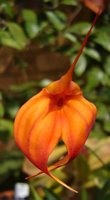 Masdevallia Heathii. An intoxicating flame, this is a cross between Masd. ignea and Masd. veitchiana made, not surprisingly, by Heath at the end of the 19th century. The flowers are large for the size of the dimunitive plant and seem to glow from within. They are carried singly on very long, thin inflorescences and seem disembodied, like will o' the wisps leading you to your demise in the dark places of the old forest. Incendiary.
Masdevallia Heathii. An intoxicating flame, this is a cross between Masd. ignea and Masd. veitchiana made, not surprisingly, by Heath at the end of the 19th century. The flowers are large for the size of the dimunitive plant and seem to glow from within. They are carried singly on very long, thin inflorescences and seem disembodied, like will o' the wisps leading you to your demise in the dark places of the old forest. Incendiary.
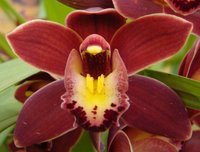 Cymbidium Ivy Fung 'Red Radiance'. This is a very beautiful compact Cymbidium with sex dream dark flowers. It is such a strong grower and flowers very reliably. It will often produce two inflorescences per pseudobulb. My only complaint is that these are really difficult to stake upright, being very rigid. So I just let it run riot, unstaked, with the inflorescences protruding at awkward angles from the base of the pot. Upright inflorescences are a human aesthetic convention at any rate, and not necessarily the natural thing for a specific orchid to produce. Stubborn.
Cymbidium Ivy Fung 'Red Radiance'. This is a very beautiful compact Cymbidium with sex dream dark flowers. It is such a strong grower and flowers very reliably. It will often produce two inflorescences per pseudobulb. My only complaint is that these are really difficult to stake upright, being very rigid. So I just let it run riot, unstaked, with the inflorescences protruding at awkward angles from the base of the pot. Upright inflorescences are a human aesthetic convention at any rate, and not necessarily the natural thing for a specific orchid to produce. Stubborn.
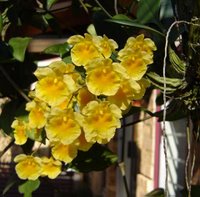 Dendrobium lindleyi. The undeniable star of the season. It is historically known as Den. aggregatum but is now named after the English botanist Lindley. This species hails from the hot jungles of Vietnam and other South East Asian countries. After a dry winter rest, pendulous inflorescences arise from the nodes of the pseudobulbs, quickly producing sulphur yellow flowers with gigantic crystalline lips. A true spring spectacle. Imagine the effort the plant has to go through to produce such exquisite blooms in such profusion. Even a small plant such as mine managed to make four inflorescences. Imagine what a giant specimen in the wild must look like. Now if only it wasn't for all that pesky napalm and Agent Orange stuff... Precious.
Dendrobium lindleyi. The undeniable star of the season. It is historically known as Den. aggregatum but is now named after the English botanist Lindley. This species hails from the hot jungles of Vietnam and other South East Asian countries. After a dry winter rest, pendulous inflorescences arise from the nodes of the pseudobulbs, quickly producing sulphur yellow flowers with gigantic crystalline lips. A true spring spectacle. Imagine the effort the plant has to go through to produce such exquisite blooms in such profusion. Even a small plant such as mine managed to make four inflorescences. Imagine what a giant specimen in the wild must look like. Now if only it wasn't for all that pesky napalm and Agent Orange stuff... Precious.
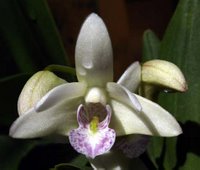 Dendrobium Brengle. A 21st century cross between Den. Glamour and Den. King-Wong. It pretty much resembles Den. x delicatum, which is a natural hybrid between Den. kingianum and Den. speciosum. It packs a lot of Ausie punch into a small package. Similar in gestalt to Den. kingianum, but with shaplier pseudobulbs and bigger flowers, it emits a barely perceptible musky honeyed scent during the early evening. Adjective-hungry.
Dendrobium Brengle. A 21st century cross between Den. Glamour and Den. King-Wong. It pretty much resembles Den. x delicatum, which is a natural hybrid between Den. kingianum and Den. speciosum. It packs a lot of Ausie punch into a small package. Similar in gestalt to Den. kingianum, but with shaplier pseudobulbs and bigger flowers, it emits a barely perceptible musky honeyed scent during the early evening. Adjective-hungry.
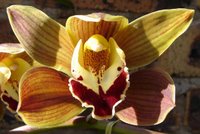 Cymbidium hybrid. Another lovely heirloom. It makes very long inflorescences for a Cymbidium, with the large copper flowers spaced far apart on the descending part of it. It makes a good garden plant, so long as you give it bright light for a large part of the day, and excellent air circulation around the root system. Droopy.
Cymbidium hybrid. Another lovely heirloom. It makes very long inflorescences for a Cymbidium, with the large copper flowers spaced far apart on the descending part of it. It makes a good garden plant, so long as you give it bright light for a large part of the day, and excellent air circulation around the root system. Droopy.
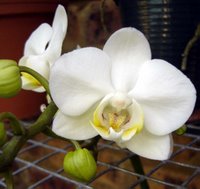 Phalaenopsis Ho's Amaglad. A wonderful cold-tolerant Phalaenopsis. This is the only plant of its kind in my collection not to have lost any leaves during the winter months. It looks like a simple variety of Phal. aphrodite, but actually contains a complex mix of genes from Phal. amabilis, Phal, equestris and Phal. stuartiana. It produces a branching inflorescence with long-lasting, pure white blooms. The yellow detail on the intricate lip is especially striking. Phalaenopsis seem almost tired and overused, like the flavour-of-last-month pot plants of decor and lifestyle magazines. But let me ask you this: how can one ever tire of true beauty? It is timeless. Classic.
Phalaenopsis Ho's Amaglad. A wonderful cold-tolerant Phalaenopsis. This is the only plant of its kind in my collection not to have lost any leaves during the winter months. It looks like a simple variety of Phal. aphrodite, but actually contains a complex mix of genes from Phal. amabilis, Phal, equestris and Phal. stuartiana. It produces a branching inflorescence with long-lasting, pure white blooms. The yellow detail on the intricate lip is especially striking. Phalaenopsis seem almost tired and overused, like the flavour-of-last-month pot plants of decor and lifestyle magazines. But let me ask you this: how can one ever tire of true beauty? It is timeless. Classic.
 Dendrobium nobile 'Joyful Heart'. I purchased this Himalayan plant for R50,00 from MC Orchids several years ago. Then, it was a cute little ikebana of a plant, with a couple of spindly canes with velvety pink flowers on them. Since then, it has grown into a splendid specimen plant, a monster that entirely covers the large coconut-fibre basket it grows in. I completely stop watering it by the end of May, when its resting period commences. All the leaves from the previous season's growth drop off, leaving the canes completely bare. By the end of July, tiny buds start to form at the nodes of the bare canes. These develop into gorgeous trusses of flowers like the one you see here. My favourite is the inviting, dark velvety centre and the dangerously spicy scent. Furry.
Dendrobium nobile 'Joyful Heart'. I purchased this Himalayan plant for R50,00 from MC Orchids several years ago. Then, it was a cute little ikebana of a plant, with a couple of spindly canes with velvety pink flowers on them. Since then, it has grown into a splendid specimen plant, a monster that entirely covers the large coconut-fibre basket it grows in. I completely stop watering it by the end of May, when its resting period commences. All the leaves from the previous season's growth drop off, leaving the canes completely bare. By the end of July, tiny buds start to form at the nodes of the bare canes. These develop into gorgeous trusses of flowers like the one you see here. My favourite is the inviting, dark velvety centre and the dangerously spicy scent. Furry. Laeliocattleya Trick or Treat. How delicious is this? Bright vermillion, starry flowers are completely irresistable and there are many similar Laeliocattleyas to choose from. Lc. Trick or Treat is one of the best and most famous of these miniature jewels and was hybridised in the 1970's by the experts at Stewart Orchids. Zesty.
Laeliocattleya Trick or Treat. How delicious is this? Bright vermillion, starry flowers are completely irresistable and there are many similar Laeliocattleyas to choose from. Lc. Trick or Treat is one of the best and most famous of these miniature jewels and was hybridised in the 1970's by the experts at Stewart Orchids. Zesty. Oncidium hybrid. Karen Little gave this plant to me for my birthday about two years ago. The tag listed it as Oncidium flexuosum, which it definitely is not. The size and shape of the pseudobulbs is completely different, not to mention the patterning on the flowers. It's very possible that Onc. flexuosum features somewhere in this plant's parentage, but without a proper tag, it is impossible to be certain. Whatever the exact genetic make up, this is a superior plant with a large (almost 1m tall!) and branching inflorescence carrying hundreds of perfectly formed yellow flowers with red and brown markings. It grows outside in bright but filtered sunlight, receiving lots of water and fresh air. I love it. Bright.
Oncidium hybrid. Karen Little gave this plant to me for my birthday about two years ago. The tag listed it as Oncidium flexuosum, which it definitely is not. The size and shape of the pseudobulbs is completely different, not to mention the patterning on the flowers. It's very possible that Onc. flexuosum features somewhere in this plant's parentage, but without a proper tag, it is impossible to be certain. Whatever the exact genetic make up, this is a superior plant with a large (almost 1m tall!) and branching inflorescence carrying hundreds of perfectly formed yellow flowers with red and brown markings. It grows outside in bright but filtered sunlight, receiving lots of water and fresh air. I love it. Bright. Cymbidium hybrid. This is an orphan I inherited from my aunt when she moved to George. It had a name tag nestled in the potting mix, but it was too eroded to be read. I repotted the plant immediately, dividing it and placing my divisions in terracotta pots filled with large chunks of composted pine bark. This year, the divisions each made two spikes of graceful jade blooms with intricately patterned lips. Graceful.
Cymbidium hybrid. This is an orphan I inherited from my aunt when she moved to George. It had a name tag nestled in the potting mix, but it was too eroded to be read. I repotted the plant immediately, dividing it and placing my divisions in terracotta pots filled with large chunks of composted pine bark. This year, the divisions each made two spikes of graceful jade blooms with intricately patterned lips. Graceful. Masdevallia Copper Angel 'Highlands'. Masdevallias are rude and obscene harlots. They appeal to the senses with their perfect symmetry and curiously glowing colours, luring you into the very centre of the flower where the reproductive parts are hiding, like a dirty secret. They are impossible to photograph accurately. This one is a primary cross between Masd. triangularis and Masd. veitchiana. It is a deep orange colour, with dark burgundy hairs all over this orange base, giving the impression of a luminescent sheen that moves over the surface as it bobs in the breeze. Fluorescent.
Masdevallia Copper Angel 'Highlands'. Masdevallias are rude and obscene harlots. They appeal to the senses with their perfect symmetry and curiously glowing colours, luring you into the very centre of the flower where the reproductive parts are hiding, like a dirty secret. They are impossible to photograph accurately. This one is a primary cross between Masd. triangularis and Masd. veitchiana. It is a deep orange colour, with dark burgundy hairs all over this orange base, giving the impression of a luminescent sheen that moves over the surface as it bobs in the breeze. Fluorescent.  Rhyncholaelia glauca. Yummy. This is sometimes known as Brassavola glauca, but is actually quite different from individuals in that genus. This species is found in open hot forests in Central America. It is glaucous, the leaves having a waxy blue appearance. Single 12cm flowers are produced from the newest pseudobulbs. Drying out between waterings is imperative for this species and as you can see, mine is quite happy growing on a log mount. I like the tiny red detail right in the centre of the lip that draws the pollinating insect right into the middle. Would this plant compete for pollinator attention with cactus flowers of similar appearance? Both are white and emit a strong perfume at night and would therefore be visited by moths. I haven't read anything to that effect, but it seems very likely. Pristine.
Rhyncholaelia glauca. Yummy. This is sometimes known as Brassavola glauca, but is actually quite different from individuals in that genus. This species is found in open hot forests in Central America. It is glaucous, the leaves having a waxy blue appearance. Single 12cm flowers are produced from the newest pseudobulbs. Drying out between waterings is imperative for this species and as you can see, mine is quite happy growing on a log mount. I like the tiny red detail right in the centre of the lip that draws the pollinating insect right into the middle. Would this plant compete for pollinator attention with cactus flowers of similar appearance? Both are white and emit a strong perfume at night and would therefore be visited by moths. I haven't read anything to that effect, but it seems very likely. Pristine. Dendrobium kingianum. Possibly the easiest of all orchids to grow. It has a profusion of shapely dusky pink flowers in spring. It is a coastal lithophyte from eastern Australia. There are thousands of named varieties, some with speckles or stripes, some which are pure white and some the colour of a good red wine. Keep it in dappled light, provide an open potting mix and water it once a week. I fertilize mine when I remember (which is seldom) and it seems to do just fine. Really difficult to kill, perhaps a little tricky to grow really well. Use your intuition and your Den. kingianum will reward you. Accommodating.
Dendrobium kingianum. Possibly the easiest of all orchids to grow. It has a profusion of shapely dusky pink flowers in spring. It is a coastal lithophyte from eastern Australia. There are thousands of named varieties, some with speckles or stripes, some which are pure white and some the colour of a good red wine. Keep it in dappled light, provide an open potting mix and water it once a week. I fertilize mine when I remember (which is seldom) and it seems to do just fine. Really difficult to kill, perhaps a little tricky to grow really well. Use your intuition and your Den. kingianum will reward you. Accommodating. Pleurothallis truncata. What a lovely and curious group of orchids the Pleurothallids are. I've read accounts of explorers who entered the deepest parts of Andean cloud forests to find that the dominant vegetation is Pleurothallids, simply covering every dripping surface. There are over 1000 species in the genus Pleurothallis, and many in related genera like Restrepia and Dracula. I purchased this one from Afri-Orchids this year and am quite pleased with it. It is a cool growing native of Ecuador and thrives at high altitudes, where temperatures are constant and rain abundant. Each flower is about a third of a centimetre in diameter. Curious.
Pleurothallis truncata. What a lovely and curious group of orchids the Pleurothallids are. I've read accounts of explorers who entered the deepest parts of Andean cloud forests to find that the dominant vegetation is Pleurothallids, simply covering every dripping surface. There are over 1000 species in the genus Pleurothallis, and many in related genera like Restrepia and Dracula. I purchased this one from Afri-Orchids this year and am quite pleased with it. It is a cool growing native of Ecuador and thrives at high altitudes, where temperatures are constant and rain abundant. Each flower is about a third of a centimetre in diameter. Curious. Oncidium Gower Ramsey. This is supposed to be one of the best Oncidium crosses ever made. It pales in comparison to Karen's lovely no name brand cross above, though. It's pretty standard as modern hybrid Oncidiums go, being nice and compact with a good flower count and lasting power. I've glued some cuttings from it onto a Cordyline in the garden and they seem to handle Highveld epiphytic life very well indeed. The common name for Oncidium is 'Dancing Doll' or 'Dancing Lady' from the way the lip resembles a flamenco dancer's skirt. The scientific name Oncidium, however, refers to the cancer-like growths at the base of the lip (from Greek = onkos, a tumour). Not what you expected, right? Sweet.
Oncidium Gower Ramsey. This is supposed to be one of the best Oncidium crosses ever made. It pales in comparison to Karen's lovely no name brand cross above, though. It's pretty standard as modern hybrid Oncidiums go, being nice and compact with a good flower count and lasting power. I've glued some cuttings from it onto a Cordyline in the garden and they seem to handle Highveld epiphytic life very well indeed. The common name for Oncidium is 'Dancing Doll' or 'Dancing Lady' from the way the lip resembles a flamenco dancer's skirt. The scientific name Oncidium, however, refers to the cancer-like growths at the base of the lip (from Greek = onkos, a tumour). Not what you expected, right? Sweet.  Masdevallia Heathii. An intoxicating flame, this is a cross between Masd. ignea and Masd. veitchiana made, not surprisingly, by Heath at the end of the 19th century. The flowers are large for the size of the dimunitive plant and seem to glow from within. They are carried singly on very long, thin inflorescences and seem disembodied, like will o' the wisps leading you to your demise in the dark places of the old forest. Incendiary.
Masdevallia Heathii. An intoxicating flame, this is a cross between Masd. ignea and Masd. veitchiana made, not surprisingly, by Heath at the end of the 19th century. The flowers are large for the size of the dimunitive plant and seem to glow from within. They are carried singly on very long, thin inflorescences and seem disembodied, like will o' the wisps leading you to your demise in the dark places of the old forest. Incendiary. Cymbidium Ivy Fung 'Red Radiance'. This is a very beautiful compact Cymbidium with sex dream dark flowers. It is such a strong grower and flowers very reliably. It will often produce two inflorescences per pseudobulb. My only complaint is that these are really difficult to stake upright, being very rigid. So I just let it run riot, unstaked, with the inflorescences protruding at awkward angles from the base of the pot. Upright inflorescences are a human aesthetic convention at any rate, and not necessarily the natural thing for a specific orchid to produce. Stubborn.
Cymbidium Ivy Fung 'Red Radiance'. This is a very beautiful compact Cymbidium with sex dream dark flowers. It is such a strong grower and flowers very reliably. It will often produce two inflorescences per pseudobulb. My only complaint is that these are really difficult to stake upright, being very rigid. So I just let it run riot, unstaked, with the inflorescences protruding at awkward angles from the base of the pot. Upright inflorescences are a human aesthetic convention at any rate, and not necessarily the natural thing for a specific orchid to produce. Stubborn. Dendrobium lindleyi. The undeniable star of the season. It is historically known as Den. aggregatum but is now named after the English botanist Lindley. This species hails from the hot jungles of Vietnam and other South East Asian countries. After a dry winter rest, pendulous inflorescences arise from the nodes of the pseudobulbs, quickly producing sulphur yellow flowers with gigantic crystalline lips. A true spring spectacle. Imagine the effort the plant has to go through to produce such exquisite blooms in such profusion. Even a small plant such as mine managed to make four inflorescences. Imagine what a giant specimen in the wild must look like. Now if only it wasn't for all that pesky napalm and Agent Orange stuff... Precious.
Dendrobium lindleyi. The undeniable star of the season. It is historically known as Den. aggregatum but is now named after the English botanist Lindley. This species hails from the hot jungles of Vietnam and other South East Asian countries. After a dry winter rest, pendulous inflorescences arise from the nodes of the pseudobulbs, quickly producing sulphur yellow flowers with gigantic crystalline lips. A true spring spectacle. Imagine the effort the plant has to go through to produce such exquisite blooms in such profusion. Even a small plant such as mine managed to make four inflorescences. Imagine what a giant specimen in the wild must look like. Now if only it wasn't for all that pesky napalm and Agent Orange stuff... Precious. Dendrobium Brengle. A 21st century cross between Den. Glamour and Den. King-Wong. It pretty much resembles Den. x delicatum, which is a natural hybrid between Den. kingianum and Den. speciosum. It packs a lot of Ausie punch into a small package. Similar in gestalt to Den. kingianum, but with shaplier pseudobulbs and bigger flowers, it emits a barely perceptible musky honeyed scent during the early evening. Adjective-hungry.
Dendrobium Brengle. A 21st century cross between Den. Glamour and Den. King-Wong. It pretty much resembles Den. x delicatum, which is a natural hybrid between Den. kingianum and Den. speciosum. It packs a lot of Ausie punch into a small package. Similar in gestalt to Den. kingianum, but with shaplier pseudobulbs and bigger flowers, it emits a barely perceptible musky honeyed scent during the early evening. Adjective-hungry. Cymbidium hybrid. Another lovely heirloom. It makes very long inflorescences for a Cymbidium, with the large copper flowers spaced far apart on the descending part of it. It makes a good garden plant, so long as you give it bright light for a large part of the day, and excellent air circulation around the root system. Droopy.
Cymbidium hybrid. Another lovely heirloom. It makes very long inflorescences for a Cymbidium, with the large copper flowers spaced far apart on the descending part of it. It makes a good garden plant, so long as you give it bright light for a large part of the day, and excellent air circulation around the root system. Droopy. Phalaenopsis Ho's Amaglad. A wonderful cold-tolerant Phalaenopsis. This is the only plant of its kind in my collection not to have lost any leaves during the winter months. It looks like a simple variety of Phal. aphrodite, but actually contains a complex mix of genes from Phal. amabilis, Phal, equestris and Phal. stuartiana. It produces a branching inflorescence with long-lasting, pure white blooms. The yellow detail on the intricate lip is especially striking. Phalaenopsis seem almost tired and overused, like the flavour-of-last-month pot plants of decor and lifestyle magazines. But let me ask you this: how can one ever tire of true beauty? It is timeless. Classic.
Phalaenopsis Ho's Amaglad. A wonderful cold-tolerant Phalaenopsis. This is the only plant of its kind in my collection not to have lost any leaves during the winter months. It looks like a simple variety of Phal. aphrodite, but actually contains a complex mix of genes from Phal. amabilis, Phal, equestris and Phal. stuartiana. It produces a branching inflorescence with long-lasting, pure white blooms. The yellow detail on the intricate lip is especially striking. Phalaenopsis seem almost tired and overused, like the flavour-of-last-month pot plants of decor and lifestyle magazines. But let me ask you this: how can one ever tire of true beauty? It is timeless. Classic. 
6 comments:
I love the "rude and obscene harlots." Your place must be alive with colour!
I love that Copper Angel! It looks so unusual.
My mother used to have lots of those Dendrobium kingianums. Hmmm. It would be quite interesting to pick up an art like orchid growing.
i think the rhyncolaelia glauca is my favourite. very mysterious and intriguing.
I'm glad that one I gave you is still doing well...
Neither of my orchids has done anything yet. Do you think it's me?
hi there.
I will copy some of your orchid pics to make some dolls. Can I use the pics next to my dolls pics on my blog and webpage??
my e-mail is: claudiarbastos@yahoo.com.br
Sure! All photographs on my blog are free to use. I would appreciate a link or mention, though.
Post a Comment